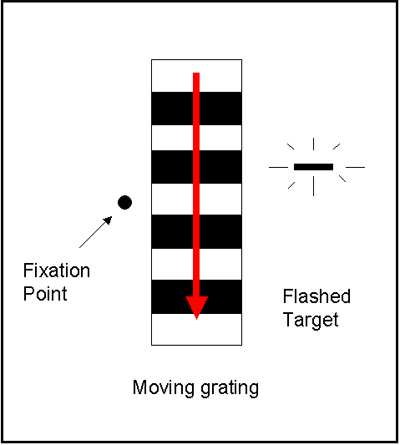

 When you reach out to pick up your coffee cup, the cup is not the only thing you see. Your eye is confronted with all kinds of motion signals, some of which are caused by the movement of your eye and head as you look at the cup and some of which are caused by the movement of other objects in the scene. To accurately reach out to the cup, it has always been assumed that your visuomotor system must somehow separate information about the location of the cup from the irrelevant background motion signals on the retina. Our experiments provide evidence that, counterintuitively, the visuomotor system does not do this at all. In a recent experiment, my former postdoc, David Whitney (now at UC Berkeley), and I (together with my former postdoc, David Westwood) have shown that when observers reach to a stationary object, motion signals that are unrelated to the target (e.g., other moving objects) cause significant deviations in the hand’s trajectory. Although this seems counterproductive and contrary to our everyday experience, it might, in fact, be precisely the reason we are able to reach successfully for objects: since retinal motion is most commonly caused by eye and head movements, the visuomotor system might use these signals as a quick way of computing how our body’s position has changed with respect to the target, and how much we have to correct our hand’s trajectory to compensate for this. In other words, the fact that the visuomotor system conflates the position of the target with the background motion may be an adaptive mechanism for quickly updating visually guided actions. Such a computation could be made directly on the basis of retinal information and would require no additional input from other sensory or motor systems.
When you reach out to pick up your coffee cup, the cup is not the only thing you see. Your eye is confronted with all kinds of motion signals, some of which are caused by the movement of your eye and head as you look at the cup and some of which are caused by the movement of other objects in the scene. To accurately reach out to the cup, it has always been assumed that your visuomotor system must somehow separate information about the location of the cup from the irrelevant background motion signals on the retina. Our experiments provide evidence that, counterintuitively, the visuomotor system does not do this at all. In a recent experiment, my former postdoc, David Whitney (now at UC Berkeley), and I (together with my former postdoc, David Westwood) have shown that when observers reach to a stationary object, motion signals that are unrelated to the target (e.g., other moving objects) cause significant deviations in the hand’s trajectory. Although this seems counterproductive and contrary to our everyday experience, it might, in fact, be precisely the reason we are able to reach successfully for objects: since retinal motion is most commonly caused by eye and head movements, the visuomotor system might use these signals as a quick way of computing how our body’s position has changed with respect to the target, and how much we have to correct our hand’s trajectory to compensate for this. In other words, the fact that the visuomotor system conflates the position of the target with the background motion may be an adaptive mechanism for quickly updating visually guided actions. Such a computation could be made directly on the basis of retinal information and would require no additional input from other sensory or motor systems.
Whitney, D., Westwood, D. A., & Goodale, M. A. (2003). The influence of visual motion on fast reaching movements to a stationary object. Nature, 423, 869-873.
Download pdf or Download pdf of supplemental material